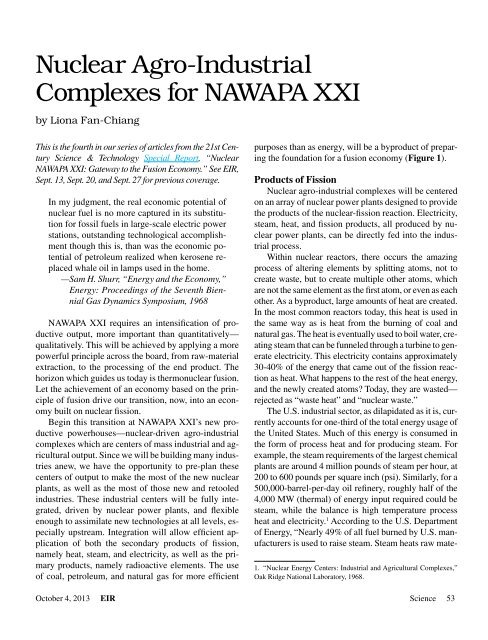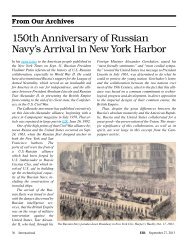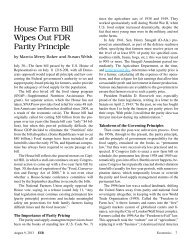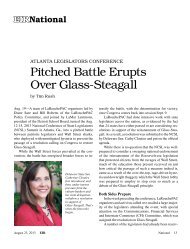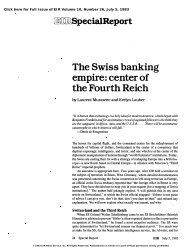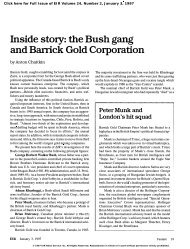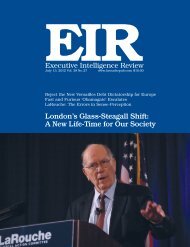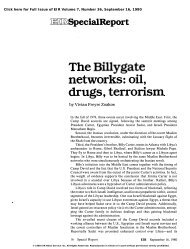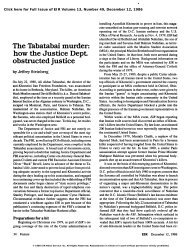Nuclear Agro-Industrial Complexes for NAWAPA XXI
Nuclear Agro-Industrial Complexes for NAWAPA XXI
Nuclear Agro-Industrial Complexes for NAWAPA XXI
You also want an ePaper? Increase the reach of your titles
YUMPU automatically turns print PDFs into web optimized ePapers that Google loves.
<strong>Nuclear</strong> <strong>Agro</strong>-<strong>Industrial</strong><br />
<strong>Complexes</strong> <strong>for</strong> <strong>NAWAPA</strong> <strong>XXI</strong><br />
by Liona Fan-Chiang<br />
This is the fourth in our series of articles from the 21st Century<br />
Science & Technology Special Report, “<strong>Nuclear</strong><br />
<strong>NAWAPA</strong> <strong>XXI</strong>: Gateway to the Fusion Economy.” See EIR,<br />
Sept. 13, Sept. 20, and Sept. 27 <strong>for</strong> previous coverage.<br />
In my judgment, the real economic potential of<br />
nuclear fuel is no more captured in its substitution<br />
<strong>for</strong> fossil fuels in large-scale electric power<br />
stations, outstanding technological accomplishment<br />
though this is, than was the economic potential<br />
of petroleum realized when kerosene replaced<br />
whale oil in lamps used in the home.<br />
—Sam H. Shurr, “Energy and the Economy,”<br />
Energy: Proceedings of the Seventh Biennial<br />
Gas Dynamics Symposium, 1968<br />
<strong>NAWAPA</strong> <strong>XXI</strong> requires an intensification of productive<br />
output, more important than quantitatively—<br />
qualitatively. This will be achieved by applying a more<br />
powerful principle across the board, from raw-material<br />
extraction, to the processing of the end product. The<br />
horizon which guides us today is thermonuclear fusion.<br />
Let the achievement of an economy based on the principle<br />
of fusion drive our transition, now, into an economy<br />
built on nuclear fission.<br />
Begin this transition at <strong>NAWAPA</strong> <strong>XXI</strong>’s new productive<br />
powerhouses—nuclear-driven agro-industrial<br />
complexes which are centers of mass industrial and agricultural<br />
output. Since we will be building many industries<br />
anew, we have the opportunity to pre-plan these<br />
centers of output to make the most of the new nuclear<br />
plants, as well as the most of those new and retooled<br />
industries. These industrial centers will be fully integrated,<br />
driven by nuclear power plants, and flexible<br />
enough to assimilate new technologies at all levels, especially<br />
upstream. Integration will allow efficient application<br />
of both the secondary products of fission,<br />
namely heat, steam, and electricity, as well as the primary<br />
products, namely radioactive elements. The use<br />
of coal, petroleum, and natural gas <strong>for</strong> more efficient<br />
purposes than as energy, will be a byproduct of preparing<br />
the foundation <strong>for</strong> a fusion economy (Figure 1).<br />
Products of Fission<br />
<strong>Nuclear</strong> agro-industrial complexes will be centered<br />
on an array of nuclear power plants designed to provide<br />
the products of the nuclear-fission reaction. Electricity,<br />
steam, heat, and fission products, all produced by nuclear<br />
power plants, can be directly fed into the industrial<br />
process.<br />
Within nuclear reactors, there occurs the amazing<br />
process of altering elements by splitting atoms, not to<br />
create waste, but to create multiple other atoms, which<br />
are not the same element as the first atom, or even as each<br />
other. As a byproduct, large amounts of heat are created.<br />
In the most common reactors today, this heat is used in<br />
the same way as is heat from the burning of coal and<br />
natural gas. The heat is eventually used to boil water, creating<br />
steam that can be funneled through a turbine to generate<br />
electricity. This electricity contains approximately<br />
30-40% of the energy that came out of the fission reaction<br />
as heat. What happens to the rest of the heat energy,<br />
and the newly created atoms? Today, they are wasted—<br />
rejected as “waste heat” and “nuclear waste.”<br />
The U.S. industrial sector, as dilapidated as it is, currently<br />
accounts <strong>for</strong> one-third of the total energy usage of<br />
the United States. Much of this energy is consumed in<br />
the <strong>for</strong>m of process heat and <strong>for</strong> producing steam. For<br />
example, the steam requirements of the largest chemical<br />
plants are around 4 million pounds of steam per hour, at<br />
200 to 600 pounds per square inch (psi). Similarly, <strong>for</strong> a<br />
500,000-barrel-per-day oil refinery, roughly half of the<br />
4,000 MW (thermal) of energy input required could be<br />
steam, while the balance is high temperature process<br />
heat and electricity. 1 According to the U.S. Department<br />
of Energy, “Nearly 49% of all fuel burned by U.S. manufacturers<br />
is used to raise steam. Steam heats raw mate-<br />
1. “<strong>Nuclear</strong> Energy Centers: <strong>Industrial</strong> and Agricultural <strong>Complexes</strong>,”<br />
Oak Ridge National Laboratory, 1968.<br />
October 4, 2013 EIR Science 53
FIGURE 1<br />
Power Conversion Unit Generator<br />
Turbine<br />
Commercial Power<br />
Power <strong>for</strong> Electrolysis<br />
1<br />
2<br />
3<br />
4<br />
1. Low Pressure<br />
Compressor<br />
2. Primary Heat<br />
Rejection<br />
Blower<br />
Pump<br />
Hydrogen Production<br />
(Electrolysis)<br />
Hydrogen<br />
3. High Pressure<br />
Compressor<br />
4. Recuperator<br />
Heat Exchanger<br />
Pebble-bed or<br />
Prismatic Reactor<br />
Blower<br />
Heat Exchangers<br />
Hydrogen Production<br />
(Thermochemical)<br />
Hydrogen<br />
Heat transfer from a nuclear reactor<br />
Idaho National Laboratory<br />
rials and treats semi-finished products. It is also a<br />
power source <strong>for</strong> equipment, facility heating, and<br />
electricity generation.” 2<br />
<strong>Nuclear</strong>-powered industrial complexes, with<br />
their array of reactors, 3 can be designed to supply<br />
the heat needs of many different industries—industries<br />
which require steam at different temperatures<br />
and pressures, as well as direct heat at a<br />
higher range of temperatures.<br />
Steam from nuclear plants, paired with the<br />
nearby coolant water source provided by <strong>NAWAPA</strong><br />
<strong>XXI</strong>, and supplemented by desalinated water from<br />
desalination plants, can meet many of the intense<br />
water requirements of industry and agriculture (Figure 2).<br />
While steam temperature requirements are typically<br />
in the range of 120-540°C (250-1,000°F), direct heat<br />
temperature requirements are often much higher, at 800-<br />
2,000°C (1,500-3,600°F). <strong>NAWAPA</strong> <strong>XXI</strong> will require<br />
2. U.S. Department of Energy Steam Systems<br />
3. Besides having more flexibility to add reactors, the arrangement of<br />
reactors in a bundle, all feeding into the same set of steam, electricity,<br />
and heat infrastructure, allows the freedom to have one or two in maintenance<br />
at any one time, without affecting the supply to industries,<br />
many of which run continually. Since steam and process heat are not as<br />
easily transported as electricity, this will all have to be preplanned into<br />
reactor designs.<br />
FIGURE 2<br />
Water Use Type<br />
100<br />
Chemicals<br />
80<br />
Petroleum Refining<br />
Pulp and Paper<br />
60<br />
Primary Metals<br />
40<br />
Food Processing<br />
20<br />
0<br />
Cooling Process Water Boiler Feed Other<br />
Source: Water Ellis, Use <strong>Industrial</strong> Type Water Use and Its Energy Implications<br />
Breakdown of how each type of industry uses water. Boiler feedwater is<br />
water used to supply a boiler to generate steam or hot water.<br />
Percent (%)<br />
approximately 300 million tons of steel, 4 requiring temperatures<br />
up to 1,370°C (2,500°F) with current technologies,<br />
and approximately 540 million tons of cement,<br />
which require temperatures up to 1,450°C (2,640°F).<br />
Below is diagram of a few industrial processes and their<br />
temperature requirements (Figure 3).<br />
You can see that the second- and third-generation<br />
nuclear reactors of today are not able to meet the requirements<br />
of most of these common industrial processes.<br />
Fourth-generation reactors can meet a majority<br />
4. The annual U.S. steel production <strong>for</strong> 2013 is estimated at 65 million<br />
tons. (http://www.steel.org/About%20AISI/Statistics.aspx)<br />
54 Science EIR October 4, 2013
FIGURE 3<br />
Iron Industry<br />
Cement Manufacture<br />
Ammonium<br />
Coal Processing<br />
Coal Gasification, Thermo-Chemical Hydrogen Production<br />
Production of Ethylene from Naphtha or Ethane<br />
Synthetic Gas and Hyrdrogen from Natural Gas or Naphtha<br />
Petroleum Refineries<br />
Ammonia Production<br />
Crude Oil Desulferization<br />
Oil Refining<br />
Paper and Pulp Production<br />
Urea Synthesis<br />
0<br />
100<br />
Generation II Reactors<br />
Seawater Desalination, District Heating<br />
200<br />
300<br />
400<br />
500<br />
600<br />
700<br />
800<br />
900<br />
1000<br />
1100<br />
1200<br />
Temperature (Degrees Celsius)<br />
1300<br />
1400<br />
1500<br />
1600<br />
1700<br />
Generation III Reactors<br />
Generation IV Reactors<br />
Comparison of common industrial-process heat-temperature requirements, with nuclear-reactor temperatures. 1<br />
1. Produced from figures obtained from Majumdar, “Desalination and Other Non-electric Applications of <strong>Nuclear</strong> Energy,” IAEA, Lectures given at the<br />
Workshop on <strong>Nuclear</strong> Reaction Data and <strong>Nuclear</strong> Reactors: Physics, Design and Safety, Trieste, 25 February-28 March, 2002.<br />
October 4, 2013 EIR Science 55
of these needs, and these will<br />
have to be fast-tracked, out of the<br />
testing phase they are in today.<br />
The broad use of high-temperature<br />
fourth-generation nuclear<br />
reactors in these production units<br />
will change the whole industrial<br />
landscape. Not only will they<br />
serve to replace low-energy-density<br />
coal, oil, and natural gas <strong>for</strong><br />
many current industrial processes,<br />
but more importantly, they will<br />
create new types of industries and<br />
products, while reshaping and<br />
multiplying the productive output<br />
of existing industries. For example,<br />
among many other uses, the<br />
centralized mass production and<br />
delivery of hydrogen could replace<br />
two-thirds of the production<br />
cycle <strong>for</strong> ammonia (NH 3<br />
), one of<br />
the most widely produced inorganic<br />
chemicals in the world. 5<br />
Many more technological<br />
breakthroughs will need to be<br />
made to eventually replace the<br />
higher heat requirements currently<br />
being supplied by fossil<br />
fuels. Once abundant electricity,<br />
steam, and heat, at increasingly<br />
FIGURE 4<br />
Energy-Flux Density<br />
higher temperatures, are available, many methods of<br />
production evolve and many previously exotic products,<br />
such as more advanced specialty steels than can be<br />
produced today, will be integrated into mass production,<br />
providing the plat<strong>for</strong>m <strong>for</strong> a fusion economy.<br />
Figure 4 shows the energy content of different fuel<br />
sources. One pound of petroleum produces 6.4 kWh of<br />
energy, while, with breeder reactors, which breed notyet-fissile<br />
fertile fuel into burnable fissile fuel during operation,<br />
1 pound of uranium can potentially produce<br />
18,900 kWh. 6 If you have ever been stopped at a railroad<br />
crossing to wait <strong>for</strong> a coal train to pass by, then you have<br />
seen a part of the vast amount of infrastructure, time, and<br />
5. Eighty-three percent of ammonia is used <strong>for</strong> fertilizer. Currently, the<br />
constituents of ammonia, hydrogen, and nitrogen are obtained from natural<br />
gas (or liquified petroleum gases, such as propane and butane), air,<br />
and high-temperature steam (700-1,100°C). The process creates carbon<br />
dioxide and water as byproducts.<br />
6. In breeder reactors, non-fissile Th-232 and U-238 absorb neutrons to<br />
eventually become fissile U-233 and Pu-239, respectively.<br />
LPAC<br />
This progression of cones of increasing pitch show the natural progession of sources of<br />
fuels of higher energy density. Apexes represent the time of their discovery. As a new cone<br />
reaches the previous one, the old technology becomes eclipsed in its use in the economy.<br />
Both the rate of discovery, and the relative energy ratios are increasing dramatically.<br />
Deuterium is used here as the fuel <strong>for</strong> fusion reactions.<br />
manpower consumed by the use of approximately 1 billion<br />
tons every year in the United States alone. In contrast,<br />
breeder reactors can be designed to burn the initial<br />
fuel <strong>for</strong> the lifetime of the plant, eliminating the fuel<br />
transportation cost after installation altogether.<br />
As can also be seen in Figure 4, human economy has<br />
always been based on progressing toward use of fuels<br />
of higher energy density. However, fuel is only a reflection<br />
of the underlying principle in operation at any one<br />
time. This type of progression must occur at all levels,<br />
not just at the fuel source.<br />
Advanced Industry and the <strong>Nuclear</strong> Plat<strong>for</strong>m<br />
Nonlinear increases in productivity will not come<br />
from better integration alone. Replacement, as much as<br />
possible, of machine tools, with already available computer<br />
numerical control (CNC) laser machine tools, is<br />
a way to introduce the high energy-flux density of laser<br />
technology into all the processes downstream. Many<br />
other uses of lasers throughout the economy, such as<br />
56 Science EIR October 4, 2013
PERIMETER FARM ROAD<br />
FIGURE 5<br />
<strong>Nuclear</strong>-Powered <strong>Agro</strong>-<strong>Industrial</strong> Complex<br />
FARM SUPPORT AREA<br />
EQUIPMENT AND PROCESSING<br />
FARM<br />
FARM<br />
VERTICAL SHAFT<br />
PUMPS<br />
CANAL<br />
CORRIDOR ROAD<br />
STORAGE<br />
IRRIGATION MAINS<br />
FEED INTO SPRINKLERS<br />
VILLAGE AREA<br />
FAMILY FARM PLOTS<br />
TWO 66-KV TRANSMISSION LINES<br />
UNDERGROUND PRODUCT WATER<br />
PIPELINE TO FARM<br />
SALT FARM<br />
TOWN<br />
NUCLEAR INDUSTRIAL WATER COMPLEX<br />
(SEE SEPARATE ILLUSTRATION)<br />
Oak Ridge National Laboratory<br />
This is a 1967 proposed design of an agricultural-industrial nuclear-powered complex by Oak Ridge National Laboratory. The<br />
image shows that industrial centers can be embedded into agricultural areas which benefit from both the industrial output,<br />
including electricity and fertilizers, and the desalinated water supplied by the complex. Underground piping takes water through<br />
irrigation mains to a sprinkler system. Storage and processing equipment is on site. These agricultural units will use the locally<br />
supplied desalinated water—or water newly derived from <strong>NAWAPA</strong> <strong>XXI</strong>—<strong>for</strong> irrigating soil, <strong>for</strong> hydro- and aquaculture, and <strong>for</strong><br />
growing trees and other vegetation <strong>for</strong> both food, and <strong>for</strong> land, water, and weather reclamation. Advances in the industrial sector<br />
will feed into agriculture’s goal of continually increasing the technology density per area of land.<br />
the tuned catalyzing of chemical reactions, will also<br />
drastically increase the rate and quality of production<br />
(Figure 5). 7<br />
The use of low- and high-temperature plasmas <strong>for</strong><br />
processing material such as steel will also have a large<br />
impact on the productive process. Requiring some of<br />
the highest temperatures of common industrial processes,<br />
steelmaking can largely be transferred over to<br />
furnace designs which will utilize the very high temperatures<br />
and other properties of plasmas to process the<br />
iron ore into any desired steel alloy. 8 Ultimately, besides<br />
the coolant, the temperature limit of fission reactor<br />
designs will be determined by materials increasingly<br />
capable of handling high heat, corrosion, and<br />
neutron degradation. These limits, however, are not inherent<br />
to magnetically confined plasmas. High-temperature<br />
plasmas, and ultra-high-temperature plasmas of<br />
controlled thermonuclear fusion, can reach millions<br />
7. See “The <strong>Nuclear</strong> <strong>NAWAPA</strong> <strong>XXI</strong> & The New Economy,” Appendix<br />
2 (http://larouchepac.com/nawapaxxi).<br />
8. The plasma arc design is already in use today, though not widely.<br />
and tens of millions of degrees Celsius. With them,<br />
humans will be able to interact with, and control matter,<br />
the way the Sun does. With fusion plasmas, humans<br />
will even be able to synthesize needed bulk raw materials<br />
from the contents of landfills.<br />
Yet another upgrade in the productive process comes<br />
from the most valuable product of the fission reaction.<br />
The remnants of the fission reaction are high-grade ores,<br />
which not only contain elements which we commonly<br />
use, but also isotopes which cannot be, or are not easily,<br />
found in nature. Breeder reactors, which “breed” more<br />
fissile fuel during operation, can potentially use up all<br />
the larger, more radioactive elements (the actinides,<br />
having atomic numbers 89-103), leaving behind neutron-absorbing<br />
fission products. Like “waste heat,” it is<br />
also now called “nuclear waste,” and considered a hindrance<br />
to the fission process. Rather than a hindrance,<br />
fission products must be a primary product of specialized<br />
reactors, designed specifically to create, collect,<br />
and deliver these valuable resources. Fission products,<br />
such as molybdenum-99, which is not found in nature,<br />
but whose decay product, technetium-99m, is used<br />
October 4, 2013 EIR Science 57
FIGURE 6<br />
<strong>Nuclear</strong> <strong>Industrial</strong> Water Complex<br />
WATER PIPELINE TO FARMS<br />
ALUMINUM PRODUCTION<br />
AMMONIA<br />
DESALINATION<br />
PHOSPHOROUS<br />
H2<br />
Oak Ridge National Laboratory<br />
This bird’s eye view of a 1968 Oak Ridge National Laboratory design of a prototype nuclear-powered industrial complex, shows six<br />
main industrial processes: aluminum, ammonia, hydrogen, phosphorous, and desalinated water, all feeding off of the electricity,<br />
heat, and steam from the three nuclear power plants near the center. A small channel brings in ocean water <strong>for</strong> cooling and<br />
desalinating. A pipeline runs desalinated water out to farms. Oak Ridge designed the complex so that material would be mostly<br />
transported within the complex by conveyor belt (broken lines). Also included in the center are research facilities, fire station,<br />
machine shop, and administrative facilities.<br />
widely <strong>for</strong> life-saving medical imaging, are already important<br />
factors in our standard of living (Figure 6).<br />
Well-funded research into the nature and uses of the<br />
controlled transmutation of elements, especially into natural<br />
transmutation within the biological realm, is long<br />
overdue. In addition, the full ability to make and manipulate<br />
isotopically pure materials, by exploiting their particular<br />
resonance frequencies, will define a completely<br />
new degree of freedom, of which we see only a glimmer<br />
in the current uses of isotopes (primarily as radioisotopes). 9<br />
Conclusion<br />
During the construction of <strong>NAWAPA</strong> <strong>XXI</strong>, nuclear-industrial<br />
complexes would be ideal <strong>for</strong> new industries<br />
in the Great Lakes area, where the raw materials<br />
<strong>for</strong> steel production are in close proximity. Plants<br />
9. Forty percent of the world radioisotope supply comes from Chalk<br />
River Laboratories in Ontario, Canada. Only laboratory amounts are<br />
produced in the United States.<br />
producing over 50 GW of electricty will be located in<br />
and around Idaho <strong>for</strong> the most demanding of the water-pumping<br />
requirements of the <strong>NAWAPA</strong> <strong>XXI</strong> water-distribution<br />
system. These plants provide much<br />
more than electricity, if used to produce more nuclear<br />
plants, as well as other materials needed <strong>for</strong> the construction<br />
of <strong>NAWAPA</strong> <strong>XXI</strong>. Nearby will be medical<br />
research facilities, as well as plasma research facilities,<br />
preparing the way to a fusion economy. Units in<br />
Alaska can be specialized to produce warm working<br />
environments, and supply nearby emerging cities. Agricultural<br />
units, with embedded industrial units, could<br />
be placed in the Southwest, along the <strong>NAWAPA</strong> <strong>XXI</strong><br />
route, or along its tributaries. Each will be tailored to<br />
the specific required industrial or agricultural cycles.<br />
These units will be crucial <strong>for</strong> developing the Pacific<br />
Development Corridor, strung along the corridor like<br />
the cities which connected the east and west of the<br />
United States during the construction of the transcontinental<br />
railroad.<br />
58 Science EIR October 4, 2013


